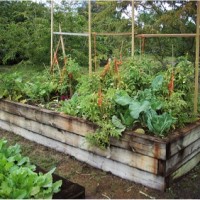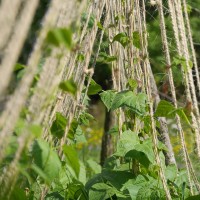Off the Grid – Veggie Gardens
If you’re living off the grid, producing your own water and power, then you’re probably growing all or a portion of your own food in a garden. However, if you are still in the planning stages of going off the grid, if your grocery bills are out of control, or if you just don’t trust the produce that makes it to your market these days, setting up a home garden is a great option. With a little work, your garden can produce enough fruits and vegetables to last a year.
Many might expect that they’ll need a massive plot for growing their food, but with careful planning and construction, bountiful produce can be grown in a 25-square-foot area. The key is careful planning before a shovel touches the dirt.
It’s All About Spacing
Anyone involved in gardening will assert that the quality of the soil is one of the most important factors in putting together a productive garden. Trying to incorporate loose soil and fertilizers into existing soil can be challenging, depending on your soil type. In addition, your existing soil might not be ideal for the type of produce you wish to grow. Therefore, the best approach is to build raised beds for growing produce. Experts say that raised beds can produce four times as much produce due to less soil, efficient spacing, and the lack of paths or rows. Also, by placing plants close together, the plants grow close enough so that they will block out the growth of underlying weeds..
The other space-saving strategy is to round out the top of the beds. Even though this doesn’t seem like something that would provide a lot of extra room, just adding a single foot of surface width, when multiplied by the length of the bed, can expand the growing space. Couple that with filling the edges with leafy greens, such as lettuce and spinach, and every square inch can be used.
Next, instead of the age-old, row planting within the raised planting boxes, try planting in triangles instead. This will efficiently space the plants. One word of caution however: be conscious of how tightly you plant. The garden’s yield will decrease if the plants are too close to each other.
Go Vertical
Whether or not you have the space to let crops wander endlessly, you get a higher yield if vining crops are directed vertically onto trellises, cages, stakes or fencing. This is common with tomatoes. Plastic or metal cone-like cages are available at most plant supply stores. However, keep in mind that, depending on your type of tomato, err on the side of providing greater space.
I learned the hard way when my single Sun Gold tomato plant quickly outgrew the medium-size cage, and required a makeshift fencing trellis for it to keep growing. That one plant ended up producing 20-30 pounds of little “sunnies.”
Even though larger fruit plants, such as squash and cucumbers, seem as though they’d be better off on the ground, they too are more than capable of growing on a trellis. The stems will grow thicker to help support the weight, and the rest of your garden with thank you for keeping those behemoths from overrunning your other plants.
Companion Planting
Another useful strategy is companion planting, which means planting certain combinations of plants together, because as they can thrive alongside or on top of each other. One example, is planting corn, beans and squash in the same space. The corn grows tall, the beans grow up the corn stalk, and the squash covers the ground to block out any weeds. By incorporating the right companions in your garden, you can expect higher yields, less nuisance insects, and fewer weeds that need puling.
According to organicgardening.com, some winning combinations include roses and chives, tomatoes and cabbage, cucumbers and nasturtiums, corn and beans, and cabbage and dill.
Succession Planting
Again, by putting together a proper plan, you can grow three-to-four crops within the same space, over the course of an extended growing season. If you choose crops that like to grow during parts of the season that don’t overlap, you can fit them all in. For instance, you could plant an early variety of lettuce, followed by a fast-growth corn, then more lettuce and maybe some root produce that can handle frost, such as garlic.
To make this work, there are some things to keep in mind:
- Use starters – purchase or start your plants in a blister pack. This allows for a long growing phase outside the bed and, when it’s ready, it can be transplanted into the garden at its peak.
- Choose a faster-growing variety of the plant.
- Sew in a good layer of compost/fertilizer in between plantings to replenish the nutrients absorbed by the previous crop.
Start Early, End Late
Last, when trying to maximize how much your garden yields, extending the growing season is a sure-fire ticket to success. By setting up areas to keep the air from getting too cold, or the soil from getting nipped by Jack Frost, you’ll allow the plants to keep growing instead of wilting over. One advantage to having raised beds is that you can use flexible PVC plumbing arced over the beds to create makeshift greenhouses. If this won’t work, use shielded blankets or other protection to provide the barrier needed to keep things growing.
Of course, all the above mentioned tricks of the trade also require proper watering. The best way to achieve the standard one-inch of water per week is to lay out soaker hoses connected to a timer. This allows both proper root saturation and dry foliage to help prevent disease. Consult the selected hose to determine the proper time length to provide optimal watering.
Armed with this knowledge and a proper plan, may your garden be as bountiful as ever, and the fruits of your labor be that much sweeter (pun intended)!

